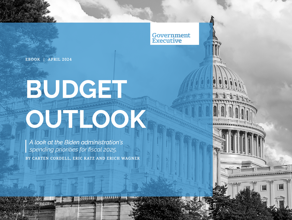Steady funding, staffing urged for executive boards
Groups can play a key role in crisis, but support and expectations need to be clear, panelists say at hearing.
Federal Executive Boards can play a major role in disaster response, but they could benefit from more staff, consistent funding and standard performance expectations, witnesses said at a Senate hearing Friday.
The boards were formed in 1961 and provide a forum for federal employees who work outside Washington, D.C., to coordinate their efforts.
The Office of Personnel Management "oversees FEBs, but the staff is usually employed by a local agency detailee," said Sen. Daniel Akaka, D-Hawaii. "They do not receive specific appropriated funds. Some have an executive director, some have no permanent staff at all. Each one of the 28 FEBs seems to have it own funding and operating structure."
The boards have to be "very entrepreneurial," Kimberly Ainsworth, executive director of the Greater Boston FEB, told members of the Homeland Security and Governmental Affairs subcommittee that oversees federal workforce and management issues. "I know I can ask for any level of resources, be it a case of copy paper or a person," she testified. "That said, I think it's a hat in hand approach. We're constantly going back and asking for these things, and that might dry up at some point."
Bernice Steinhardt, director of strategic issues at the Government Accountability Office, confirmed that some agencies had withdrawn the funding they provided to FEBs, and said organizational challenges meant that the groups' full potential was not always recognized.
"They are not included in any federal emergency plans," Steinhardt said. "By including the boards in emergency management plans, the role of the FEBs and their contributions in involving the federal workforce could be much better communicated."
Kevin Mahoney, associate director for the human capital leadership and merit system accountability division at the Office of Personnel Management, said his office has met with officials from the Federal Emergency Management Agency, and expects to have a memorandum of understanding about the role of FEBs in place by late fall and a strategic plan ready later in the winter.
"In the creation of our strategic plan, we are hoping that the FEBs will devote about 50 percent of their time to strategic planning," Mahoney said. "We do agree with GAO that there should be a process in place that identifies the role of the FEBs."
That role has the potential to be significant.
The Minnesota FEB helped build relationships among federal, state and local employees that allowed them to deal quickly and efficiently with the August collapse of a bridge in Minneapolis that killed 13 people, and heavy rains that caused flooding in September.
"The response to these disasters by all levels of government was exemplary due to one vital element: trust," said Ray Morris, executive director of the Minnesota FEB. "All of the major players knew each other by name and knew they could count on each other. No business cards were exchanged during any of these disasters."
Such relationships are built in part during training exercises that help prepare federal employees from different agencies for emergencies. "Federal Executive Boards are not equipped to serve in a first responder role," said Michael Goin, executive director of the Cleveland FEB. "However, we believe we enhance the federal response capability by sponsoring interagency training and conducting the exercises that directly impact the readiness of those responders and employees."
The boards also serve as representatives of federal employees in negotiations with state and local authorities and can take responsibility for transmitting information back to them.
Ainsworth said her board was able to perform both of those functions in the planning leading up to the 2004 Democratic National Convention in Boston. The day before the convention, reports that a small aircraft had entered restricted space and dropped off a parachutist prompted security concerns.
"The Federal Executive Board stepped in during the late evening hours and coordinated the collection of real-time information from subject-matter experts within our federal law enforcement community," she said. "We were able to quickly disseminate facts and recommendations from the public safety community."
In addition to keeping federal agencies apprised of state and local situations, FEBs can provide resources to which state and local authorities might not have access.
In Minnesota, for example, FEB has a partnership with the FBI's United States Public and Private Partnership emergency communications network. That system allows FEB officials to communicate immediately with every federal agency in the state.
FEBs also can help find staff members who may have special skills or be able to fill gaps in an emergency.
"The FEB is positioned to be a coordinating body for obtaining essential staff and personnel," said Art Cleaves, the Region 1 administrator for FEMA. "With its already established relationships with other federal agencies, the FEB could utilize its position to identify a workforce capable of assisting with a response."
These diverse capabilities and missions, and the fact that FEB employees are on assignment from their agencies, has made it complicated to set performance standards or to determine who should evaluate FEB directors. Akaka pressed the witnesses on how they thought such performance standards ought to be determined and who should evaluate the success or failure of the directors.
"We very much agree that there should be a common set of performance metrics for the FEBS," Mahoney told Akaka. "We think it's important that as we ask agencies to fund the FEBs, to show them that the FEBs are able to accomplish what we want them to."
"To the extent that OPM is setting expectations for FEBs in human capital and emergency preparedness, OPM needs to be involved in setting those standards," Steinhardt said. "One of the strengths of the FEBs is they are local, they are responsive to their regional perspective. It needs to be a collaborative effort between OPM and the agencies to determine what those standards should be."


